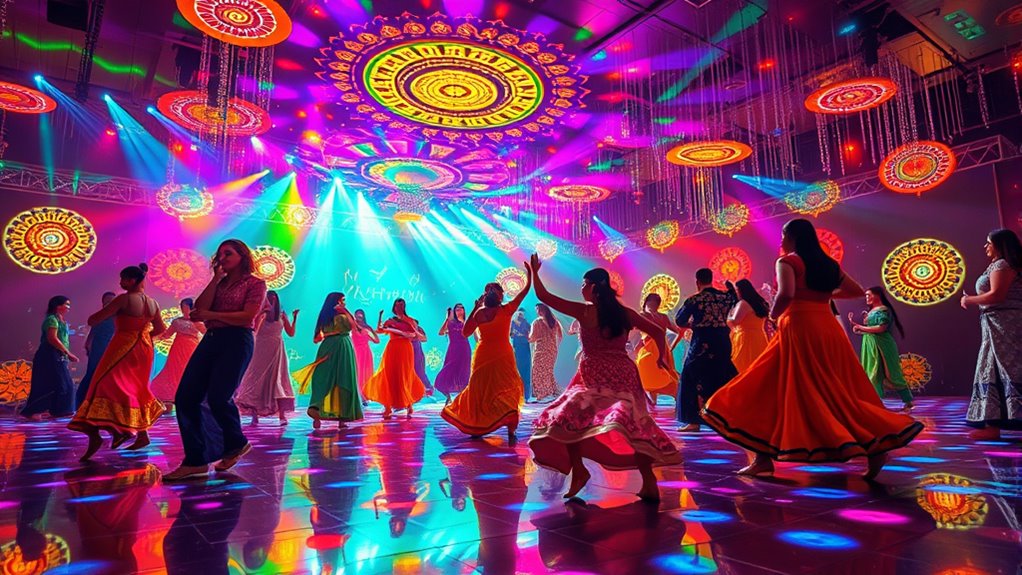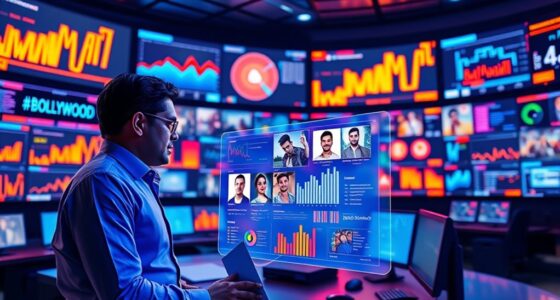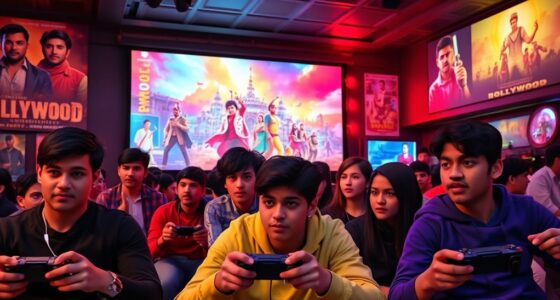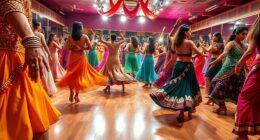Augmented reality is transforming Bollywood’s big dance numbers by creating immersive visuals, interactive experiences, and dynamic storytelling. You’ll see dancers engaging with virtual sets, stunning backgrounds, and synchronized effects that heighten excitement. This tech allows for more creative choreography and audience participation, both live and remotely. As AR continues to evolve, it promises even more innovative spectacles. Stay with us to discover how this revolution shapes the future of Bollywood dance floors.
Key Takeaways
- AR will enable immersive, real-time visual effects that elevate Bollywood dance performances and audience engagement.
- Interactive AR environments will allow dancers to respond dynamically to digital elements, enhancing storytelling.
- Motion capture and sensor technology will facilitate precise movement tracking, creating seamless integration of dancers and virtual backgrounds.
- Virtual set designs and customizable backgrounds will make large-scale performances more cost-effective and visually stunning.
- Future AR advancements will promote remote participation, expanding Bollywood’s reach and creating participatory, multi-sensory dance experiences.
The Rise of AR in Bollywood Dance Scenes
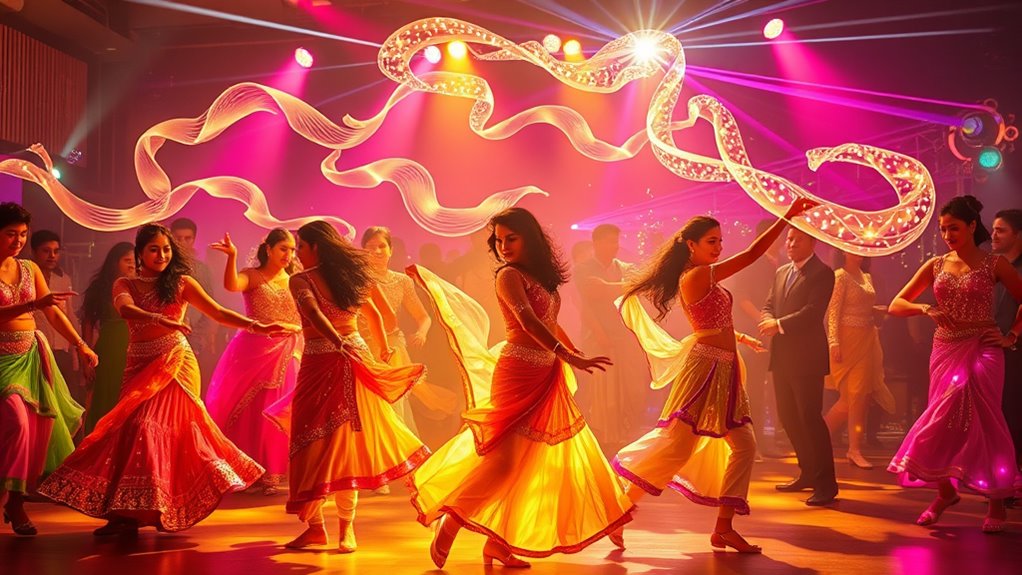
The rise of augmented reality in Bollywood dance scenes reflects a significant shift toward innovative storytelling and audience engagement. You’ll notice filmmakers increasingly use AR filters and experiences to promote movies and connect with fans. For example, Fox Star Studios’ ‘Sanju’ reached over 1.7 million people with AR filters in just a week, while Dharma Productions’ ‘2.0’ gained 3 million impressions in 36 hours, showing rapid audience traction. Excel Entertainment’s ‘Gold’ allowed actors to interactively promote the film using AR filters, making the experience more engaging. Jio Studios teamed up with AugRay to create viral group dance AR experiences, boosting organic promotion with minimal marketing. These innovations make dance sequences more immersive, interactive, and memorable, transforming traditional Bollywood dance into a dynamic digital phenomenon. AR integration in cinematic dance scenes continues to evolve, opening new avenues for creative expression and audience participation. Additionally, the technological advancements involved require cutting-edge AR tools, which are becoming more accessible to filmmakers seeking innovative ways to captivate viewers. As these tools become more widespread, the potential for advanced AR technology to enhance storytelling is expanding rapidly.
Transforming Dance Training With Augmented Reality
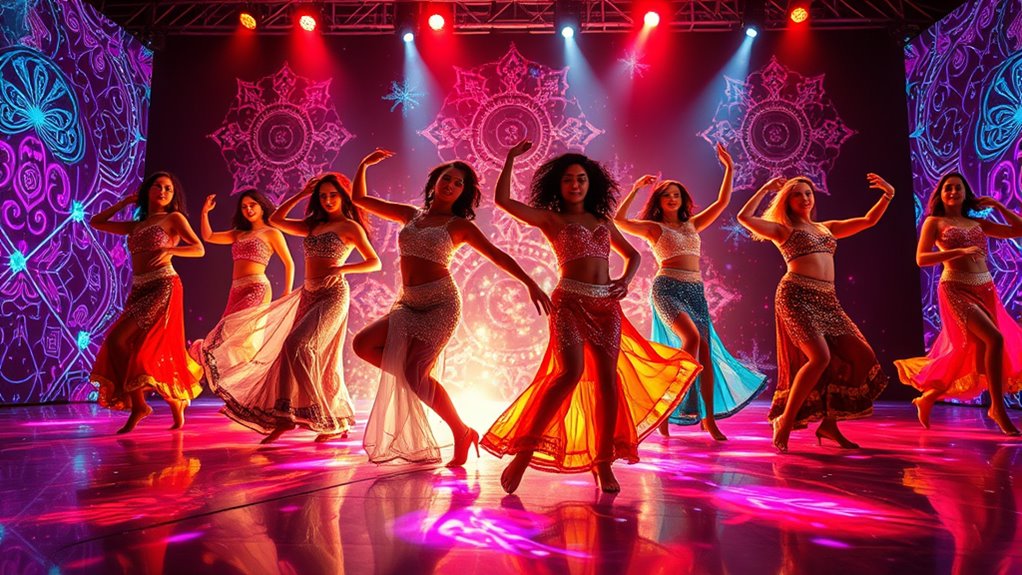
Augmented reality is revolutionizing dance training by making high-quality instruction more accessible than ever before. With AR, you can learn from renowned instructors remotely, breaking geographical barriers. It offers interactive experiences that keep you engaged and make learning more effective. AR creates personalized environments, helping you improve faster by focusing on your unique needs. It also integrates with traditional dance documentation methods like Labanotation, preserving choreography accurately. Using AR-based exercises, you can boost your balance, mobility, and technique, receiving real-time feedback to correct mistakes instantly. This technology not only enhances your practice sessions but also helps prevent injuries by identifying risky movements early. Recent studies have shown that AR systems can improve learning outcomes and increase user acceptance in dance training. Incorporating training customization features, AR adapts to your skill level and learning pace, making the experience even more tailored. Additionally, AR can incorporate motion tracking to analyze your movements precisely, ensuring proper technique and reducing the risk of injury. Furthermore, the integration of AR with advanced visualization tools allows dancers to better understand complex choreography and spatial relationships. The use of natural materials in Waldorf toys exemplifies how sustainable practices can enhance sensory experiences, which aligns with the immersive and tactile aspects of AR training. Moreover, leveraging feedback mechanisms enhances the interactive nature of AR, providing real-time correction and motivation to dancers. Overall, AR makes high-level dance training more affordable, efficient, and tailored to your progress, transforming how dancers develop their craft.
Elevating Live Performances Through Digital Enhancements
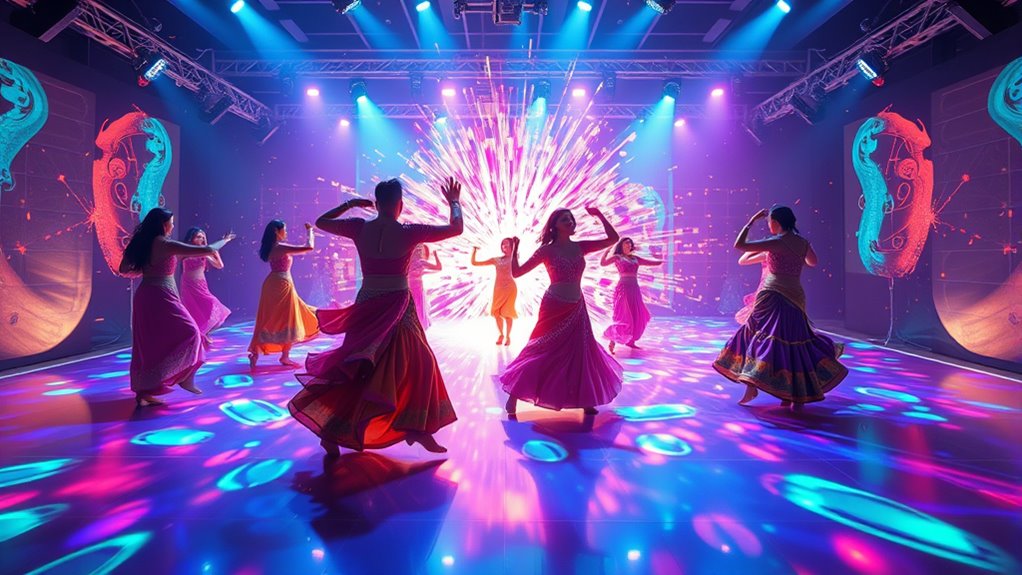
You can transform live performances by incorporating dynamic virtual set designs that captivate your audience. Interactive dancer-AR integration allows performers to engage viewers in real-time, creating a more immersive experience. Seamless live visual effects enhance the energy of the show, making every moment visually striking and unforgettable. India’s massive live sports viewership highlights the growing appetite for innovative digital experiences in entertainment, reflecting a broader trend toward digital engagement in events. Additionally, integrating AI-driven content creation can further personalize and elevate the visual spectacle, ensuring audiences remain captivated throughout the performance. The use of predictive analytics can help organizers anticipate audience responses and tailor the show accordingly.
Dynamic Virtual Set Designs
Dynamic virtual set designs transform live performances by seamlessly blending digital environments with real-time action, creating immersive experiences that captivate audiences. With advanced technology, you can craft digital environments for film, TV, and concerts that adapt instantly. Here’s how it benefits you:
- Rapid scene changes without physical set adjustments
- Real-time rendering for dynamic backgrounds
- Cost-effective production by reducing logistics
- Enhanced storytelling with visually stunning backdrops
The technology allows for greater creative flexibility, enabling artists and directors to experiment with different visual concepts effortlessly. Incorporating home improvement ideas like flexible lighting and adaptable layouts can elevate the visual appeal and thematic elements of digital set designs, making performances more engaging. Additionally, understanding the importance of Bike maintenance and setup can help ensure the technical reliability of digital projections and equipment used in live shows. The rising market value, projected growth, and industry collaborations drive this digital set innovation. Additionally, embracing technology integration in set design can streamline workflows and improve overall production efficiency. Digital sets empower creators to push boundaries, delivering memorable, engaging experiences that resonate with today’s tech-savvy audiences.
Interactive Dancer-AR Integration
Interactive Dancer-AR Integration revolutionizes live performances by blending digital elements with physical movement, creating a more engaging and immersive experience for audiences. You can see dancers interact seamlessly with virtual objects, adding new layers of storytelling and visual appeal. This technology also makes performances more accessible, allowing people with mobility challenges to enjoy dance from anywhere. While high-quality AR can be costly, it offers a cost-effective solution for smaller productions by reducing set and prop expenses. AR enables dancers to explore innovative choreography, interacting with virtual elements that expand creative possibilities. Additionally, computer vision and motion capture techniques facilitate real-time tracking of dancers’ movements, enhancing synchronization between physical and virtual components. However, technical challenges like advanced equipment and software remain. Despite these hurdles, integrating AR into live dance elevates the experience, pushing artistic boundaries and increasing audience engagement.
Seamless Live Visual Effects
Seamless live visual effects have transformed how performances captivate audiences by integrating digital elements that enhance the physical dance on stage. This integration creates a more immersive experience that draws viewers deeper into the performance. You’ll notice this through:
- Motion capture technology, which tracks dancers’ movements in real time to generate dynamic visuals synchronized with their performance. This technology allows for precise movement tracking that adapts visuals instantly, creating a more immersive experience.
- Sensor integration that captures environmental or dancer data, creating immersive experiences without overwhelming the scene. These sensors facilitate real-time data processing to ensure visuals respond seamlessly.
- Camera image processing, where live feeds produce visuals that mirror dancers’ actions, adding a layer of interaction.
- The use of minimal interaction, ensuring subtle effects that maintain a natural performance atmosphere while elevating the visual appeal. Incorporating digital augmentation enhances the overall aesthetic without detracting from the performers’ artistry.
- Advanced visual effects software enables choreographers and designers to craft complex projections and overlays that synchronize perfectly with live movements, further enriching the audience experience.
These innovations enable smooth, immediate visual responses, making performances more engaging without distracting from the artistry. Audience perception studies further highlight how different technologies influence viewer engagement and enjoyment, emphasizing the importance of balancing visual effects with the performance.
Engaging Audiences With Interactive AR Experiences
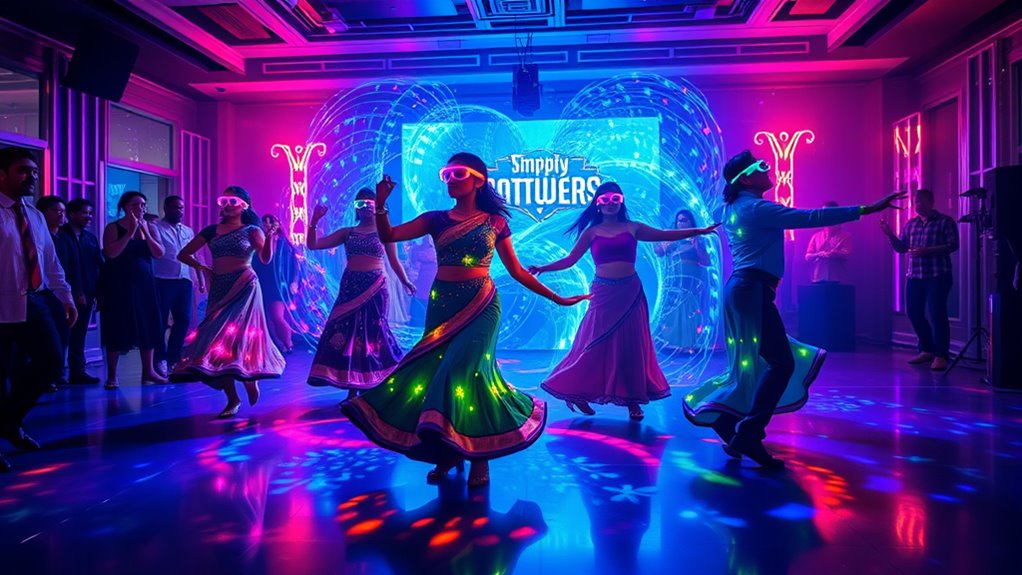
Augmented reality transforms dance performances by creating immersive experiences that draw audiences in more deeply. With AR, you can enjoy storytelling that feels alive, as visuals respond dynamically to performers’ movements. This interactivity increases your participation, making you feel like part of the action. AR also enhances emotional connections by fostering a sense of shared experience. Plus, it makes dance more accessible—people who can’t attend live shows can still engage through interactive AR features. For younger audiences, AR offers a fresh, multimedia-rich way to connect with traditional dance, blending art forms and building communities. These interactive experiences make performances more engaging, memorable, and inclusive, revolutionizing how you experience dance and opening new avenues for cultural expression. Enhances learning by allowing dancers to visualize complex movements more clearly, which further enriches audience understanding and appreciation. Additionally, leveraging best training guides can help dancers improve their technique and adapt to AR-integrated performances effectively.
Overcoming Technological Barriers in AR Integration

Integrating AR into dance performances presents several technological challenges that must be addressed for successful implementation. First, compatibility issues arise because AR systems often need specific hardware and software, which may not work with existing infrastructure. Second, high-end AR equipment can be costly, limiting access for smaller productions or independent artists. Third, a lack of technical expertise among dance professionals can hinder smooth integration. Fourth, creating synchronized AR content that matches the choreography is complex, and ensuring real-time rendering without lag or glitches is even more challenging. To overcome these barriers, you should focus on:
Overcoming AR integration challenges in dance requires compatible infrastructure, affordable solutions, skilled training, and synchronized content development.
- Upgrading infrastructure for compatibility
- Finding affordable AR solutions
- Providing targeted training
- Developing reliable, synchronized content
Envisioning the Future of AR-Driven Dance Spectacles
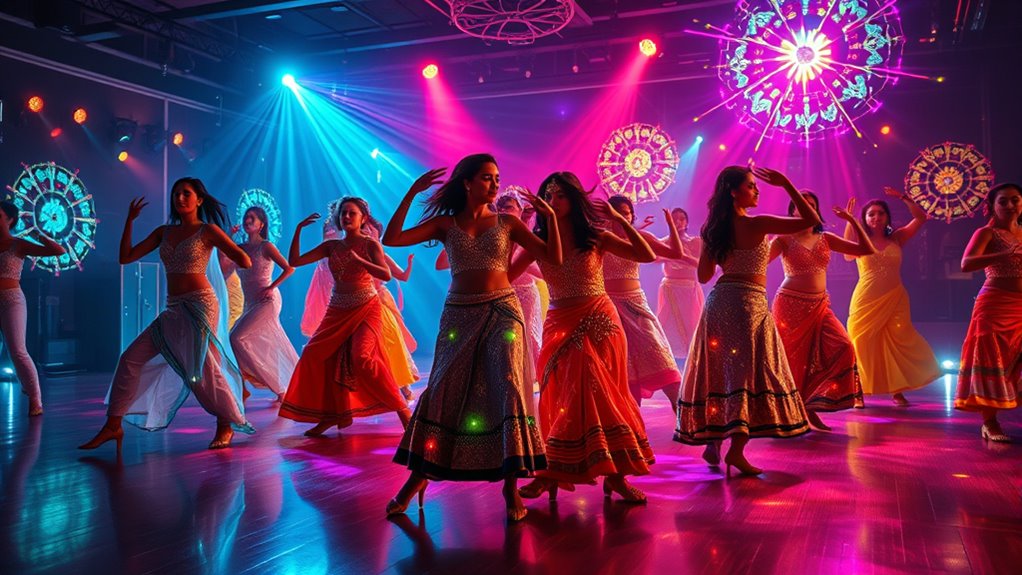
The future of AR-driven dance spectacles promises to transform how performances captivate audiences and push creative boundaries. You’ll see enhanced stage presence through interactive projections that respond to dancers’ movements, making shows more dynamic and engaging. Audience members will feel more connected via immersive experiences, with interactive elements inviting participation. Virtual participation will expand reach, letting remote viewers feel part of the action through digital projections of dancers in different locations. AR also opens new storytelling avenues, blending digital narratives with dance to deepen thematic expression. Advancements like motion capture and real-time effects will create seamless, responsive visuals. This technology can revitalize traditional dance, broaden audiences, and boost revenue, all while inspiring innovative choreography and performance concepts.
Frequently Asked Questions
How Affordable Will AR Technology Become for Small Dance Studios?
You’ll find AR technology becoming increasingly affordable for your studio. Hardware costs drop as consumer devices like smartphones and tablets become more capable and cheaper. Subscription models offer predictable monthly fees, easing budget worries. You can use user-friendly AR apps and pre-made content, reducing development costs. Plus, open-source tools and community resources help you experiment without big investments. Overall, AR will soon be accessible, allowing you to enhance your dance experiences without breaking the bank.
Can AR Replace Traditional Dance Training Methods Entirely?
Imagine a world where dance training feels almost real, yet something’s missing. You wonder if AR could replace traditional methods entirely. While AR offers speed and personalized feedback, it lacks the human touch that captures emotion and cultural depth. You can’t ignore the power of face-to-face guidance and shared energy. So, no, AR won’t fully replace traditional dance training — it’s a tool, not a substitute for authentic connection.
What Are the Privacy Concerns Related to Volumetric Capture of Dancers?
You should be aware of privacy concerns when volumetric capture records your dance movements. This data can identify you uniquely and reveal sensitive health or demographic info. You might not have control over how your data is used or shared, and it could be accessed by unauthorized parties. Additionally, capturing bystanders or private spaces raises serious privacy issues, making it essential to prioritize consent, transparency, and security.
How Will AR Affect the Authenticity of Traditional Bollywood Dance Forms?
Think of AR as a double-edged sword slicing through tradition. It can enhance your understanding and preserve dance moves digitally, making them accessible worldwide. But, it risks turning authentic expressions into shiny illusions, overshadowing the soulful nuances passed down through generations. While AR can modernize, you must guarantee it doesn’t dilute the true spirit and cultural depth of traditional Bollywood dance, keeping its heart intact amid technological evolution.
What Are the Skills Needed for Dancers to Adapt to Ar-Enhanced Performances?
You need a mix of technical and performance skills to adapt to AR-enhanced performances. Master gesture-based controls and learn to synchronize your movements precisely with digital effects. Develop your spatial awareness and timing to match virtual visuals seamlessly. Stay adaptable by experimenting with new technologies and collaborating closely with tech teams. Improving your ability to blend traditional dance with digital elements will help you deliver engaging, immersive performances in AR environments.
Conclusion
As you watch Bollywood’s dance numbers evolve with AR, it’s clear the sky’s the limit. You’re witnessing a game-changer that turns heads and keeps audiences captivated. While challenges remain, embracing this tech is a no-brainer—it’s the tip of the iceberg. So, don’t be left in the dust; get ready to dance into a future where reality and fantasy seamlessly blend on the big stage. The future’s bright, and you won’t want to miss a beat.
